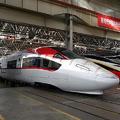Distributed propulsion – an incumbent traction method in passenger rail transport – can be useful in rail freight as well. It remains to be seen, though, what type of traction will assert itself for what range of applications. A modern, highly efficient multiple-unit cargo train should be built and its market performance compared with locomotive traction. Such a vehicle system will induce a stronger focus on innovation, it can stimulate the overdue modernisation of rail freight.
Distributed propulsion in itself isn't a magic remedy for all the woes of railways, most of all for rail freight's massive performance disadvantage (lack of flexibility, reliability, cost efficiency), compared with road transport in many respects, short-range haulage in particular.
As some R&D efforts nevertheless indicate, it will likely play a significant role in future rail freight -- partly due to other reasons than what is the case for passenger rail. Thanks to increased efficiency it can result in more freight transported by rail, improving the transport sector's energy and climate balance. Another important issue is the better use of infrastructure capacities by reducing conflicts between cargo and passenger trains - approximating speed and driving dynamics, which results in more compatible train paths.
Distributed propulsion can be a key success factor within a comprehensive innovative operating environment, including innovation in vehicles, logistics and rail operations.
Two essential guidelines:
1. While keeping vehicles as simple and maintenance-friendly as possible, multiple-unit cargo trains should convince by their technical and economic performance. That can be achieved by including available and useful elements of rail freight innovation:
- distributed traction
- middle buffer coupling (automated train composition, full-length power and auxiliary lines)
- digitalisation
- integration of logistics (on-board facilities including load tracking, optional loading robots)
- flexible, reliable train control solution (any desired train length)
- modern braking system (automated brake tests, adapted brake power etc.)
- continuous routes thanks to mixed traction (no loco changes at system borders)
- possibility for automated gauge change
- load and asset protection solutions
- redundancies in view of maximum operational reliability
- automation (train composition, driver assistance, safety, logistics)
- compatibility with existing and anticipated standards in rolling stock (integration of future innovation)
2. Vehicle technology and multi-modal logistics should be strictly in line with current market standards.
- No proprietary special solutions!
- Possibly no need for extra investments in track-side infrastructure and road vehicles participating in multi-modal services!
Innovation should provide answers to existing needs, comprehensive solutions to a range of problems (not just vehicle technology, and not an end in itself).
Who should buy such trains? How to finance more complex and more expensive vehicles?
By way of an increase in efficiency. Running time of cargo trains can be much higher compared with conventional rolling stock.
Multiple-unit cargo trains are certainly not the right choice for services where operators calculate with high travel time reserves (idle times) on purpose, but they are just right for services and routes where higher operational reliability and driving dynamics, the elimination of loco changes, faster return of trains, and train paths more in line with passenger services result in more flexibility and reliability, lower operational costs and higher margins.
Globally a number of approaches are known for distributed propulsion and multiple-unit freight trains. Some of them are (or have been) operational on a limited scale, most never went beyond the conceptual stage. Operating vehicles such as CargoSprinter (Germany) or Super Rail Cargo (Japan) did not assert themselves (in the long run, or on a supra-regional scale). Finance for subsequent development into a universal freight train as intended by CargoSprinter developers was never granted, and the Japanese investor seemingly had no interest either in further development or dissemination.
Thus I am not aware of any vehicle system making use of state-of-the-art distributed propulsion technology (as tried and tested in rail passenger services) for rail cargo, and certainly there is no operational rail vehicle that unites all (or almost all) of the above properties and criteria. That way, however, neither isolated innovative solutions nor technically mature intermodal freight logistics solutions are likely to achieve a sweeping success (ti. a significant modal shift in favour of rail, significantly more efficient rail freight services).
Amongst the known initiatives most of all ARON Rail Cargo System approached the above vision of a highly efficient multiple-unit cargo train. Following half a decade of unpaid contributions to this project, however, I have reached a point where -- at least for the next one or two legs -- I will take a different path from main stakeholders of ARON-RCS.
The proposal:
1. Create a consortium for building prototypes.
2. Following such a written agreement we initiate talks - on cooperation and limited transfer of rights - with the owners of rights in the ARON-RCS vehicle and logistics systems.
3. Startup, follow-up projects, global rollout (marketing the licence)
This is certainly an international initiative. ARON-RCS results are publicly known, in particular the results of a R&D project financed from EU funds. One promising approach is to concentrate on stakeholders from German-speaking countries, thus the language of this blog. In case of substantial interest from other countries all information is available, or can be made available in English (amongst other languages).
The most important is to build and successfully operate a productive cargo train as soon as possible - prototypes and first series. That is the only way to ascertain in what areas of rail and multi-modal freight is distributed propulsion of advantage, and where will conventional locomotive traction remain the best solution. Calculations and deliberations achieved to date must be substantiated under commercial conditions.

